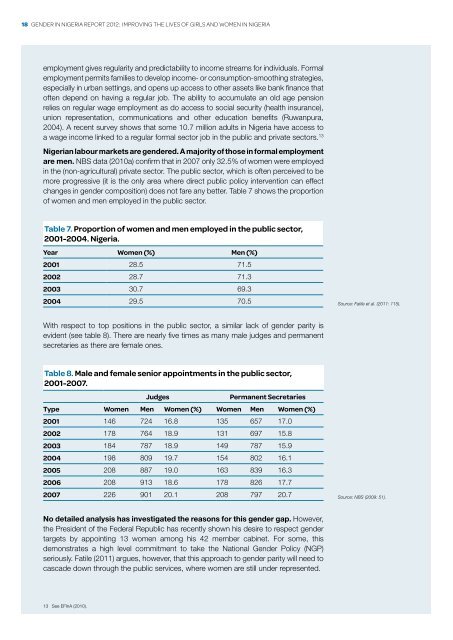Gender in niGeria report 2012 - Economic Commission for Africa
Gender in niGeria report 2012 - Economic Commission for Africa
Gender in niGeria report 2012 - Economic Commission for Africa
Create successful ePaper yourself
Turn your PDF publications into a flip-book with our unique Google optimized e-Paper software.
18 <strong>Gender</strong> <strong>in</strong> Nigeria Report <strong>2012</strong>: Improv<strong>in</strong>g the Lives of Girls and Women <strong>in</strong> Nigeria<br />
employment gives regularity and predictability to <strong>in</strong>come streams <strong>for</strong> <strong>in</strong>dividuals. Formal<br />
employment permits families to develop <strong>in</strong>come- or consumption-smooth<strong>in</strong>g strategies,<br />
especially <strong>in</strong> urban sett<strong>in</strong>gs, and opens up access to other assets like bank f<strong>in</strong>ance that<br />
often depend on hav<strong>in</strong>g a regular job. The ability to accumulate an old age pension<br />
relies on regular wage employment as do access to social security (health <strong>in</strong>surance),<br />
union representation, communications and other education benefits (Ruwanpura,<br />
2004). A recent survey shows that some 10.7 million adults <strong>in</strong> Nigeria have access to<br />
a wage <strong>in</strong>come l<strong>in</strong>ked to a regular <strong>for</strong>mal sector job <strong>in</strong> the public and private sectors. 13<br />
Nigerian labour markets are gendered. A majority of those <strong>in</strong> <strong>for</strong>mal employment<br />
are men. NBS data (2010a) confirm that <strong>in</strong> 2007 only 32.5% of women were employed<br />
<strong>in</strong> the (non-agricultural) private sector. The public sector, which is often perceived to be<br />
more progressive (it is the only area where direct public policy <strong>in</strong>tervention can effect<br />
changes <strong>in</strong> gender composition) does not fare any better. Table 7 shows the proportion<br />
of women and men employed <strong>in</strong> the public sector.<br />
Table 7. Proportion of women and men employed <strong>in</strong> the public sector,<br />
2001-2004. Nigeria.<br />
Year Women (%) Men (%)<br />
2001 28.5 71.5<br />
2002 28.7 71.3<br />
2003 30.7 69.3<br />
2004 29.5 70.5<br />
Source: Fatile et al. (2011: 115).<br />
With respect to top positions <strong>in</strong> the public sector, a similar lack of gender parity is<br />
evident (see table 8). There are nearly five times as many male judges and permanent<br />
secretaries as there are female ones.<br />
Table 8. Male and female senior appo<strong>in</strong>tments <strong>in</strong> the public sector,<br />
2001-2007.<br />
Judges<br />
Permanent Secretaries<br />
Type Women Men Women (%) Women Men Women (%)<br />
2001 146 724 16.8 135 657 17.0<br />
2002 178 764 18.9 131 697 15.8<br />
2003 184 787 18.9 149 787 15.9<br />
2004 198 809 19.7 154 802 16.1<br />
2005 208 887 19.0 163 839 16.3<br />
2006 208 913 18.6 178 826 17.7<br />
2007 226 901 20.1 208 797 20.7<br />
Source: NBS (2009: 51).<br />
No detailed analysis has <strong>in</strong>vestigated the reasons <strong>for</strong> this gender gap. However,<br />
the President of the Federal Republic has recently shown his desire to respect gender<br />
targets by appo<strong>in</strong>t<strong>in</strong>g 13 women among his 42 member cab<strong>in</strong>et. For some, this<br />
demonstrates a high level commitment to take the National <strong>Gender</strong> Policy (NGP)<br />
seriously. Fatile (2011) argues, however, that this approach to gender parity will need to<br />
cascade down through the public services, where women are still under represented.<br />
13 See EFInA (2010).

















